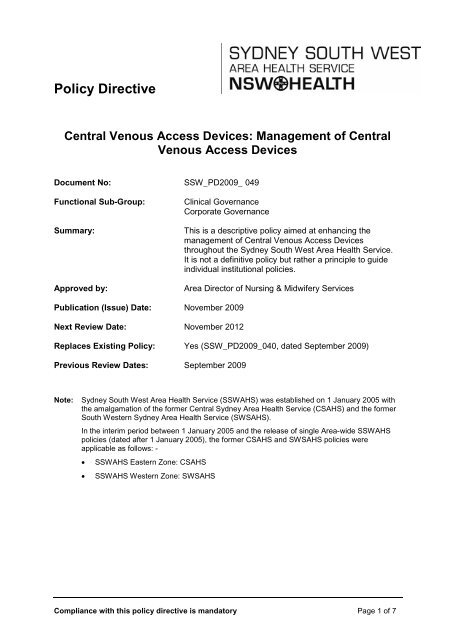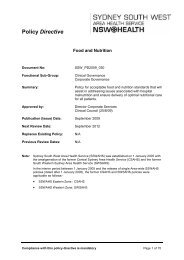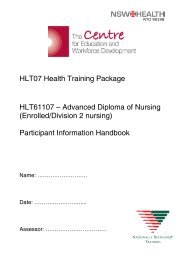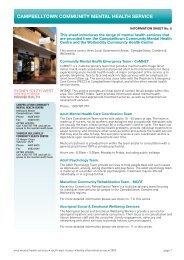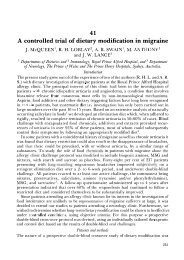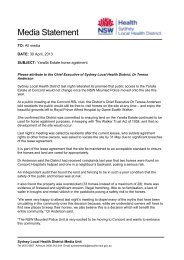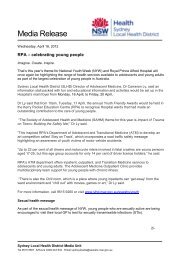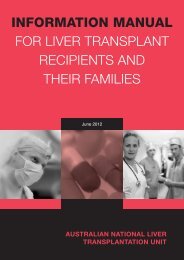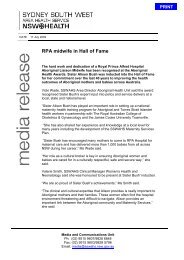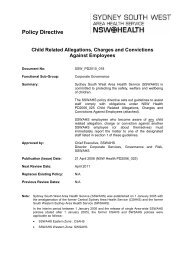Management of Central Venous Access Devices - Sydney South ...
Management of Central Venous Access Devices - Sydney South ...
Management of Central Venous Access Devices - Sydney South ...
Create successful ePaper yourself
Turn your PDF publications into a flip-book with our unique Google optimized e-Paper software.
<strong>Sydney</strong> <strong>South</strong> West Area Health ServicePolicy No: SSW_PD2009_049Date Issued: November 2009CENTRAL VENOUS ACCESS DEVICES: MANAGEMENT OF A CENTRAL VENOUSACCESS DEVICECONTENTS1. Introduction 32. Policy Statement 33. Principles/Guidelines 43.1 Accreditation3.2 Dressings3.3 Infusion Lines3.4 Heparin Locks4. Performance Measures 65. Definitions 66. References and links 6Compliance with this policy directive is mandatory Page 2 <strong>of</strong> 7
<strong>Sydney</strong> <strong>South</strong> West Area Health ServicePolicy No: SSW_PD2009_049Date Issued: November 20093.3 Administration Set Changes• Change administration sets / burettes at least every 72 - 96 hours.• IV administration / pump sets used for administering <strong>of</strong> lipid based (andsome blood) products should be changed minimum every 12 hours - this isrecommended by the CDC, CINA & RNAO (Canada), INS, AVA and manyother Parenteral Nutrition organisations (for 3:1 PN with lipids)• With some blood products (whole blood and components), administration setchanges should be every 2 hours or after 2 - 4 units (unless suspectedcontamination). Refer to SSWAHS Area policy on administration <strong>of</strong> bloodproducts. Policy No: SSW PD 2009 _005)http://intranet.sswahs.nsw.gov.au/SSWPolicies/pdf/pd2009005.pdf3.4 0.9 % Normal Saline / Heparin Lock• Each lumen must be 0.9% normal saline or heparin locked at least weeklywhen line is not in use. Heparin 50 units/5ml (Heparinised Saline) strength isused. Higher doses may be used for implanted devices or dialysis/apheresiscatheters.• Each lumen to be flushed with 0.9% normal saline prior to heparin orheparinised saline lock (to clear any medication / debris prior to instilling <strong>of</strong>heparin for lock.• A positive pressure pulsatile flushing method to be used when flushing orapplying a locking solution in all situations. This will reduce incidence <strong>of</strong>catheter-related occlusions.4. Performance Measures• Random audits <strong>of</strong> compliance with the policy regarding the management <strong>of</strong> CVADwill be performed.• Review <strong>of</strong> clinical incidents via the Incident Information <strong>Management</strong> System(IIMS) related to the management <strong>of</strong> CVAD.5. DefinitionsCVAD:<strong>Central</strong> <strong>Venous</strong> <strong>Access</strong> Device. In the context <strong>of</strong> this policy this will includeany vascular device whereby the tip <strong>of</strong> the catheter is located in the SuperiorVena Cava.Clinician: In this policy, Clinician will mean Registered Clinician/Registered Nurse6. References and Links• Legislative Compliance: Organisation, <strong>Management</strong> and Staff Obligations –SSW_PD2007_005• Code <strong>of</strong> Conduct – SSW_PD2009_001Compliance with this policy directive is mandatory Page 6 <strong>of</strong> 7
<strong>Sydney</strong> <strong>South</strong> West Area Health ServicePolicy No: SSW_PD2009_049Date Issued: November 2009• Centres for Disease Control and Prevention (2001).Guidelines for preventinginfections associated with the insertion and maintenance <strong>of</strong> central venouscatheters. Journal <strong>of</strong> Hospital Infection (2001). 47 (Supplement): S47- S67.• Cancer Nurses Society <strong>of</strong> Australia (2007). <strong>Central</strong> <strong>Venous</strong> <strong>Access</strong> <strong>Devices</strong>:Principles for Nursing Practice and Education. Cancer Nurses Society <strong>of</strong> Australia.• Registered Nurses’ Association <strong>of</strong> Ontario (2005) Care and Maintenance toReduce Vascular <strong>Access</strong> Complications, Nursing Best Practice GuidelinesProgram http://www.rnao.org/bestpractices• Claire M Rickard; Jeff Lipman; Mary Courtney; Rosemary Siversen; Peter DaleyRoutine changing <strong>of</strong> intravenous administration sets does not reduce colonizationor infection in central venous catheters. Infection Control and HospitalEpidemiology; Aug 2004; 25, 8; Health & Medical Complete pg. 650.Compliance with this policy directive is mandatory Page 7 <strong>of</strong> 7


